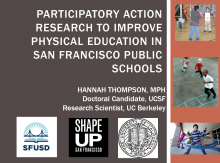We are pleased to announce an exciting new alliance between Active Living Research and GP RED to co-host and coordinate...
Participatory Action Research to Improve Physical Education in San Francisco Public Schools

Presentation at the 2014 Active Living Research Annual Conference.
Background and Purpose
The Institute of Medicine recently identified physical education (PE) as an optimal strategy to improve current youth physical activity levels, as PE provides an ideal opportunity for all students to be physically active.(1-3) In California, education policy requires that elementary students receive 200 minutes of scheduled PE every 10 days.(4) However research in California has shown suboptimal compliance with PE policy and has demonstrated that disparities exist, with schools in non-compliant districts having a significantly greater proportion of students who qualify for free or reduced-price meals.(5) To our knowledge, no research has identified best practices for ensuring compliance with state PE mandates. Strategic alliances, based on the strengths of collective action, represent groups of organizations voluntarily collaborating to address problems that are too large or complex for any one organization to solve independently.(6) Utilizing local resources and harnessing collective interest, we formed a strategic alliance (between the school district, Department of Public Health (DPH), and a research university) in order to assess local PE practices in the San Francisco Unified School District (SFUSD). The primary goal of the alliance was to improve adherence to state PE policy mandates. Analyzing the process by which strategic alliances facilitate change, as well as the barriers and facilitators that impact such change, may help improve community health.
Objectives
To detail the alliance’s actions to improve PE; to describe the impressions of those efforts on district- and school-level (systems-level) change in PE; and to identify lessons learned that could aid future alliances in achieving greater PE policy compliance.
Methods
Semi-structured interviews with 7 alliance members, 20 principals, and 50 teachers in 20 randomly selected elementary schools, 3 years post-alliance formation. All interviews were audio recorded, transcribed, and coded using a combination of the constant comparative method (to generate new grounded theories from the data) and a thematic analysis approach to segment, categorize, and link aspects of the data based on pre-determined theories, before final interpretation of the data.(7)
Results
Interviewees reported district-level increases in priority and funding for PE post-alliance’s actions. Collecting and disseminating local data contributed to the alliance’s achievements. Alliance members, principals, and teachers discussed the critical role funding plays in PE implementation and identified insufficient funding as a barrier to successful PE implementation. Interviewees described a lack of significant changes in rules and regulations regarding PE at the district-level. All of the alliance partners cited the clear identification of common goals and trust between SFUSD, the DPH, and the university as keys to the alliance’s achievements; differences in communication styles and differing opinions on best methods for disseminating data were identified as challenges.
Conclusions
Increasing PE will benefit children’s health, but creating change within a school district is complicated. Alliances may be a way to increase compliance with health policy; bringing together multiple partners with differing perspectives but shared interests may support action from multiple directions. Local data can be useful in clarifying and promoting discussions at a district level, yet school-level change may take longer to occur and may necessitate formally increasing accountability for PE at the district or state level. Future research should focus on methods to realistically and cost-effectively increase PE policy compliance, thereby increasing access to regular physical activity for youth.
Implications for Practice and Policy
School-level changes in PE policy compliance may be linked to district- or state-level accountability measures and may take longer to implement than district-level change. Further research on increasing PE policy compliance at the school-level is needed, and could include examining efforts increase the academic priority for PE by making it a core competency with common assessments, or including PE minute compliance as part of state-wide school success measures (like California’s Academic Performance Index score, which measures the academic performance and growth of schools).
References
- Institute of Medicine. Educating the Student Body: Taking Physical Activity and Physical Education to School. Concensus Report. May 2013.
- Trudeau F, Shephard RJ. Contribution of school programmes to physical activity levels and attitudes in children and adults. Sports Med. 2005;35(2):89-105.
- Madsen K, Gosliner W, Woodward-Lopez G, Crawford P. Physical activity opportunities associated with fitness and weight status among adolescents in low-income communities Arch Pediatr Adolesc Med. 2009;163(11):1014-1021.
- California State Board of Education Policy # 99-03. Education Code Section 51210. June 1999. Available at: http://www.cde.ca.gov/be/ms/po/policy99-03-june1999.asp.
- Sanchez-Vaznaugh EV, Sanchez BN, Rosas LG, Baek J, Egerter S. Physical Education Policy Compliance and Children's Physical Fitness. American journal of preventive medicine. May 2012;42(5):452-459.
- Wohlstetter P, Smith J, Mallory CL. Strategic alliances in action: toward a theory of evolution. The Policy Studies Jouranl. 2005;33(3):419-442.
- Grbich C. Qualitative data analysis : an introduction. London ; Thousand Oaks, Calif.: SAGE Publications; 2007.
Support / Funding Source
California Obesity Prevention Program and the SFUSD Public Education Enrichment Fund.
- DOWNLOAD "2014_ResearchTranslation2_Thompson.pdf" PDF (1.14 MB) Presentations
STAY UP TO DATE
RECENTLY ADDED TOOLS & RESOURCES
MOVE! A BLOG ABOUT ACTIVE LIVING
The "Active Living Conference" aims to break down research and practice silos and...







